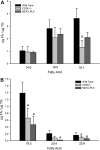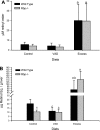Multiple pathways ensure retinoid delivery to milk: studies in genetically modified mice
- PMID: 20040693
- PMCID: PMC2853214
- DOI: 10.1152/ajpendo.00491.2009
Multiple pathways ensure retinoid delivery to milk: studies in genetically modified mice
Abstract
Retinoids are absolutely required for normal growth and development during the postnatal period. We studied the delivery of retinoids to milk, availing of mouse models modified for proteins thought to be essential for this process. Milk retinyl esters were markedly altered in mice lacking the enzyme lecithin:retinol acyltransferase (Lrat(-/-)), indicating that this enzyme is normally responsible for the majority of retinyl esters incorporated into milk and not an acyl-CoA dependent enzyme, as proposed in the literature. Unlike wild-type milk, much of the retinoid in Lrat(-/-) milk is unesterified retinol, not retinyl ester. The composition of the residual retinyl ester present in Lrat(-/-) milk was altered from predominantly retinyl palmitate and stearate to retinyl oleate and medium chain retinyl esters. This was accompanied by increased palmitate and decreased oleate in Lrat(-/-) milk triglycerides. In other studies, we investigated the role of retinol-binding protein in retinoid delivery for milk formation. We found that Rbp(-/-) mice maintain milk retinoid concentrations similar to those in matched wild-type mice. This appears to arise due to greater postprandial delivery of retinoid, a lipoprotein lipase (LPL)-dependent pathway. Importantly, LPL also acts to assure delivery of long-chain fatty acids (LCFA) to milk. The fatty acid transporter CD36 also facilitated LCFA but not retinoid incorporation into milk. Our data show that compensatory pathways for the delivery of retinoids ensure their optimal delivery and that LRAT is the most important enzyme for milk retinyl ester formation.
Figures





Similar articles
-
Retinoid absorption and storage is impaired in mice lacking lecithin:retinol acyltransferase (LRAT).J Biol Chem. 2005 Oct 21;280(42):35647-57. doi: 10.1074/jbc.M507924200. Epub 2005 Aug 22. J Biol Chem. 2005. PMID: 16115871 Free PMC article.
-
Lipoprotein lipase hydrolysis of retinyl ester. Possible implications for retinoid uptake by cells.J Biol Chem. 1994 Jun 17;269(24):16559-65. J Biol Chem. 1994. PMID: 8206972
-
Cellular retinol-binding protein type III is needed for retinoid incorporation into milk.J Biol Chem. 2005 Jun 24;280(25):24286-92. doi: 10.1074/jbc.M503906200. Epub 2005 May 3. J Biol Chem. 2005. PMID: 15870066
-
Lecithin:Retinol Acyltransferase: A Key Enzyme Involved in the Retinoid (visual) Cycle.Biochemistry. 2016 Jun 7;55(22):3082-91. doi: 10.1021/acs.biochem.6b00319. Epub 2016 May 23. Biochemistry. 2016. PMID: 27183166 Free PMC article. Review.
-
Hepatic stellate cell lipid droplets: a specialized lipid droplet for retinoid storage.Biochim Biophys Acta. 2009 Jun;1791(6):467-73. doi: 10.1016/j.bbalip.2008.11.001. Epub 2008 Nov 24. Biochim Biophys Acta. 2009. PMID: 19071229 Free PMC article. Review.
Cited by
-
A microparticle/hydrogel combination drug-delivery system for sustained release of retinoids.Invest Ophthalmol Vis Sci. 2012 Sep 19;53(10):6314-23. doi: 10.1167/iovs.12-10279. Invest Ophthalmol Vis Sci. 2012. PMID: 22918645 Free PMC article.
-
Vitamin A intake of Brazilian mothers and retinol concentrations in maternal blood, human milk, and the umbilical cord.J Int Med Res. 2018 Apr;46(4):1555-1569. doi: 10.1177/0300060518757155. Epub 2018 Feb 13. J Int Med Res. 2018. PMID: 29436245 Free PMC article.
-
Maternal Circulating Vitamin Status and Colostrum Vitamin Composition in Healthy Lactating Women-A Systematic Approach.Nutrients. 2018 May 28;10(6):687. doi: 10.3390/nu10060687. Nutrients. 2018. PMID: 29843443 Free PMC article. Review.
-
Modified relative dose response values differ between lactating women in the United States and Indonesia.Exp Biol Med (Maywood). 2020 May;245(9):797-804. doi: 10.1177/1535370220921550. Epub 2020 Apr 23. Exp Biol Med (Maywood). 2020. PMID: 32326757 Free PMC article. Clinical Trial.
-
β-Carotene Impacts the Liver MicroRNA Profile in a Sex-Specific Manner in Mouse Offspring of Western Diet-Fed Mothers: Results from Microarray Analysis by Direct Hybridization.Int J Mol Sci. 2024 Nov 30;25(23):12899. doi: 10.3390/ijms252312899. Int J Mol Sci. 2024. PMID: 39684610 Free PMC article.
References
-
- Balmer JE, Blomhoff R. Gene expression regulation by retinoic acid. J Lipid Res 43: 1773–1808, 2002 - PubMed
-
- Berger GM, Spark A, Baillie PM, Huskisson J, Stockwell G, van der Merwe E. Absence of serum-stimulated lipase activity and altered lipid content in milk from a patient with type I hyperlipoproteinaemia. Pediatr Res 17: 835–839, 1983 - PubMed
-
- Blaner WS, Das SR, Gouras P, Flood MT. Hydrolysis of 11-cis- and all-trans-retinyl palmitate by homogenates of human retinal epithelial cells. J Biol Chem 262: 53–58, 1987. - PubMed
Publication types
MeSH terms
Substances
Grants and funding
LinkOut - more resources
Full Text Sources
Molecular Biology Databases

